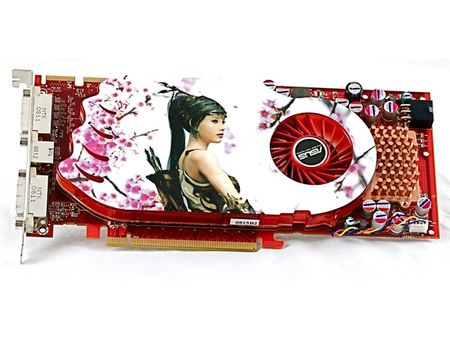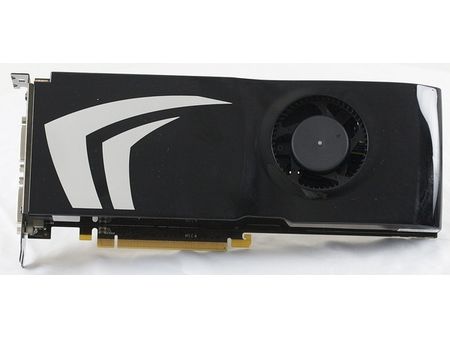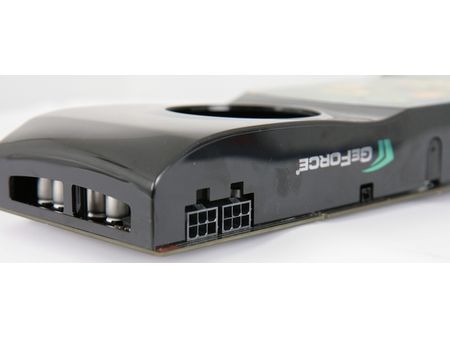ATI Radeon HD 4850: Smarter by Design?
Radeon HD 4850 (David) against 9800 GTX + (Goliath)
It’s hard not to notice the obvious physical differences between the two cards that will be vying for a place in current midrange/high-end gaming PCs, in a world where you usually need a magnifying glass to tell them apart.
The Radeon HD 4850 plays it modest, looking a lot like the HD 3850: single-slot design, a single six-pin PCI Express connector, small size (23.3 cm – 9.2") and 6-cm radial fan. And while the heat sink covers the majority of the PCB, the card is not surrounded by a wide housing that makes it impossible to tell it from other models.
The GeForce 9800 GTX +, on the other hand, is impossible to tell from the 9800 GTX physically, unless you remove the housing and heat sink to see which GPU is installed. It’s a double-slot card with two additional six-pin connectors and a thick 7-cm fan, on a board that still measures 26.7 cm (10.5"). But at least most of the heat generated by the card is vented directly outside the case, which is not true of the HD 4850.
As for outputs, both cards have two DVI dual-link connectors and a TV output. The Asus Radeon HD 4850 ships with an active DVI -> HDMI adaptor, a DVI -> VGA adaptor, the internal flexible Crossfire bridge, a Molex -> six-pin PCI Express adaptor and the HDTV connectivity. The GeForce 9800 GTX’ output connectors can also carry sound, but without an audio controller they have to be connected to the internal S/PDIF header via a cable, which has to be limited to a stereo signal (non-compressed).
The Asus model we tested turned out to be overclocked, with a GPU frequency of 680 MHz (8.8% more than the reference clock frequency) and a memory frequency of 1050 MHz (+5%). But since the overclocking is mild and the card won’t really be sold at a higher price than the others, we’ve used it in our tests as is.
Get Tom's Hardware's best news and in-depth reviews, straight to your inbox.
Current page: Radeon HD 4850 (David) against 9800 GTX + (Goliath)
Prev Page Specifications Next Page The Test-
Neog2 Wow $200 in Best Buy for a HD 4850,Reply
$450 in Best Buy for a GTX 260.
And the 4850 is pretty close to the 280.
Ouu the 4870 is going to give Nvidia a run for there money
for the first time in a while. -
Prodromaki Oced Asus and 4850 instead of 4870 + too many games based on engines favoring nVidia...Reply
P.S. +1000 -> 2222 -
For Mass Effect the Engine limits the Maximum framerate to 62FPS. You can change this in the BIOENGINE.INI file (in the Documents\BioWare\Mass Effect\Config\ folder on Vista) by changing the value:Reply
MaxSmoothedFrameRate=62 in the Engine.GameEngine section -
puterpoweruser I can't believe it took nVidia coming out with a new card again to have tom's make a review finally of the 4850.Reply
"it was unavailable due to the sloppy handling of this launch"
Seriously? AMD can't control if their retail partners screwed the pooch on the release date, because they were so anxious to get people this great product. They made sure the product was readily available well before the launch date.
They should be praised for not having a paper launch, not told that it was a sloppy launch, very poor form saying that.
Hell i went to best buy and bought 2 4850's on sunday, when the cards weren't even supposed to be available yet, the guy told me "they have been in stock for over a month in the back, they aren't supposed to be available yet but i can get two for you." Were the AMD police supposed to come and smack best buy on it's hand and keep me from giving them profits?
Sorry if i'm ranting, just put the blame where it belongs. -
Malovane No offense, Fedy Abi-Chahla and Florian Charpentier, and thanks for the hard work, but I think the article should be revised a bit. First off, this should be a review of graphics cards.. not a burned out overclocked Asus motherboard. If you attribute your 4850 test crashing due to your motherboard.. why throw in results of 0 across the board for the 4850? You just corrupted your data and made the final fps averages meaningless, which is the thing people were generally interested in. Secondly, why in the world are you including tests that don't fit the definition of "playable" on any card in your test lineup (Crysis 2560x1600). It just throws off averages, as people aren't going to run this game at 7fps! If there's no card in the lineup that gets close to 30fps in a certain test, just move on! Save it for the quad crossfire or triple sli tests or something. You're giving high weights to resolutions that only a fraction of a percentage point of dedicated gamers can utilize (and those wouldn't bother with a single GPU). Lastly, please get those annoying gigantonormous screenies out of the review. It makes the review look like it was done by kindergarteners.Reply -
puterpoweruser I didn't finish reading the whole article yet but was the driver hotfix and the current 8.6 driver applied to the 4850?? It improved performance and stability greatly as i saw, it make the actual clock speed the card is set it run nicely and gives it great overhead to overclock through the CCCReply -
draxssab Who wants the Radeon 4800 full revew? (including the 4870, that do better than the GTX 280 in some games!)Reply
http://www.hardware.fr/articles/725-8/dossier-amd-radeon-hd-4870-4850.html
In french, but the graphs talk by themselves. Ho, and if you want a short translation = impressive and incredibly more efficient than Nvidia (if you compare the size of the GPU, yes it's A LOT more efficient) -
spaztic7 These reviews are getting better! Although I have seen many benchmarks and tests of the 4850 before this, I still love seeing how the 48x0 line is doing against the green machine! Anandtech.com has a kill 4870 review!Reply


